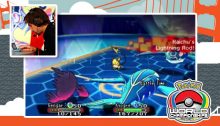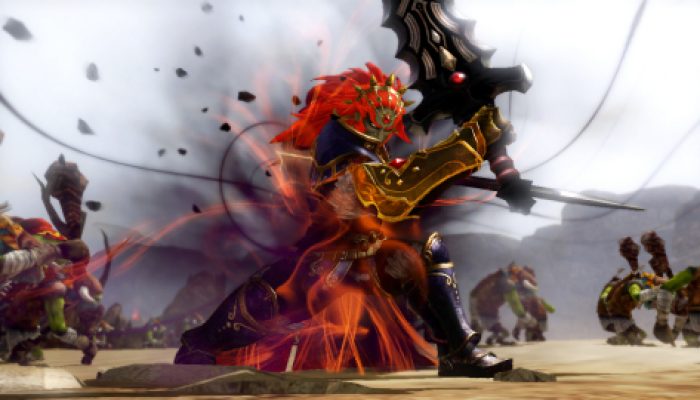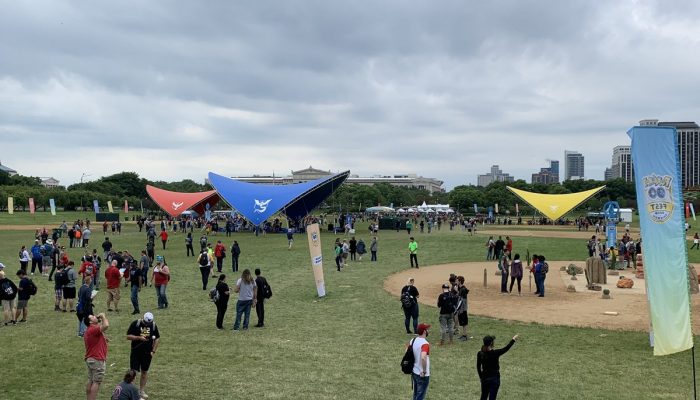 Turned out it was all about the support Pokémon.
Turned out it was all about the support Pokémon.
☆ NintendObs Weekly – Monday, September 5, 2016 – Sunday, September 11, 2016.

What Happened at the World Championships?
The biggest Pokémon Video Game World Championships ever wound up being one of the most surprising ever, too. This year, Trainers from the United States won the World Championships in all three age divisions after Japan dominated the year before. Equally surprising was that Xerneas and Smeargle each won zero World Championships after being stalwarts of the Championship Series all year long. Congratulations to Junior Division World Champion Cory Connor, Senior Division World Champion Carson Confer, and Masters Division World Champion Wolfe Glick for making smart adjustments leading into the big event!
Much like at the 2014 World Championships, where we saw a Masters Top Cut devoid of Kangaskhan after a year where it seemed like Kangaskhan was on the winning team at every other tournament, the results from San Francisco took us—and many of the competitors—off guard. Read on to find out more about how some unlikely Pokémon were able to overcome long odds to become World Champions in 2016.
Big Slips for Groudon and Xerneas
Most players and spectators expected teams using Groudon and Xerneas to dominate the World Championships. The duo was at the heart of five of the Top-8 teams in the Masters Division at the US National Championships, and they’d been the core of countless successful teams all year long. But the once-relentless success streak of this duo stopped cold in San Francisco. The pairing of Groudon and Xerneas didn’t win a championship in any of the three age divisions, and it was on only two of the Top-8 teams in the Masters Division. Instead, Kyogre helped teams win in all three age divisions, twice paired with Rayquaza and once with Groudon.
Much of what held the Groudon and Xerneas pairing back at Worlds was their own success earlier in the season. The focus placed on them leading into the competition was unmatched. Knowing that most competitors would be bringing a team they believed had a solid matchup against the format’s most popular team, many Trainers opted to play different teams instead. While it wasn’t impossible to win with a Groudon and Xerneas team—the lone undefeated player after Day 2 Swiss was Aaron Traylor, who didn’t stray from his US Nationals Groudon and Xerneas team; and Portugal’s Eduardo Cunha made it to the semifinals with the duo—the odds were pretty clearly stacked against players using Groudon and Xerneas this time. The Top Cut, with its numerous Rayquaza and Kyogre duos, along with Gengar, Bronzong, and Pokémon that were taught Roar or given Red Card to hold, left little doubt about that.
Perhaps the most important lesson players can learn from the 2016 World Championships is a simple one: Winning with the team everyone expects to be the most popular is very difficult! (Just ask the legion of Pokémon TCG competitors who brought a Night March deck to Worlds.) Bringing a team that’s the right fit to take on opponents at the World Championships is often more effective than simply picking the strongest overall team. After all, the goal for players at the World Championships is to win one particular tournament on one particular weekend—not to create a team that will see them through an entire season.
It’s been established that Groudon and Xerneas teams are extremely well optimized for the 2016 format. With Primal Groudon’s inherent power and Xerneas’s Geomancy, they may be the two strongest restricted Pokémon overall. But like all Pokémon, they have weaknesses. And those weaknesses are exploitable when other competitors have memorized the game plan against the standard team builds for these Pokémon. Trainers with both of these Pokémon on their roster had to play flawless games in San Francisco to come out ahead.
Groudon is vulnerable to Kyogre if it can’t keep its Desolate Land Ability active to defend itself from Kyogre’s Water-type attacks. Importantly, Kyogre has a massive advantage against Groudon even if Delta Stream or Air Lock is active instead of Primordial Sea or Desolate Land. Trainers using Groudon were rarely able to keep it sunny in San Francisco. Clever tactics involving Raichu and Manectric using Volt Switch, Hitmontop holding Eject Button, Bronzong using Skill Swap, and Mega Gengar’s Shadow Tag Ability allowed Kyogre and Rayquaza to override Groudon’s Desolate Land on crucial turns all weekend long.
Xerneas didn’t fare much better. The Life Pokémon has numerous strengths, but the reason it was a dominant force during the 2016 Video Game Championships season is its trademark move, Geomancy. Nearly every team had a way to negate the Speed boost of Geomancy, either through Paralysis or by reversing the turn order with Trick Room. Several Trainers took this a step further and gave one of their Pokémon a Red Card to hold or taught one of their Pokémon Roar in an effort to eject Xerneas from the field after it consumed its Power Herb. Combine that with the increased popularity of Bronzong and Gengar, and Trainers were probably thinking twice about even selecting Xerneas during team preview.
Rogue Goes Vogue
An equally important lesson from San Francisco is that there is always a new strategy to cultivate in any Pokémon Video Game Championships format. The question of how to build a team around Groudon and Xerneas was mostly solved early in the season. Trainers quickly found that they can take advantage of free turns from Smeargle’s Dark Void better than other available Pokémon. Add on top-tier Mega Evolution Pokémon and some Pokémon to help control Speed, and innovating this archetype had run its course rather early in the season.
The other powerful archetypes of the 2016 Video Game Championships season required more work to optimize. Players began building teams around Rayquaza, Kyogre, and Mega Gengar almost as soon as the season began, but it wasn’t until Wolfe Glick’s World Championships-winning team that the concept could be seen on paper as even equal to the early-season Groudon, Xerneas, and Smeargle teams. Some players may have underestimated the Rayquaza and Kyogre pairing before the World Championships because it didn’t perform well for much of the season, perhaps as a result of its being more difficult to work with than some simpler strategies. This powerful duo flew a little under the radar as players focused more of their Worlds preparation on taking down other teams—even despite a dominant Senior Division victory in Columbus.
The lack of a well-defined team structure around pairings of restricted Pokémon other than Groudon with Xerneas made the other major 2016 team archetypes more difficult to prepare for. For instance, we’ve seen many different teams built around Rayquaza and Kyogre over the year, but none truly stood out as the one to stop before the tournament. Teams using Mega Gengar were popular earlier in the season, but hadn’t earned many big finishes before Worlds. Eric Rios made a deep run at the UK National Championship with this Rayquaza-Kyogre team, but it had no other members in common with Wolfe’s winning team. Looking at Carson St. Denis’s team might have helped some players prepare for the Junior Division finals at Worlds, but his team is also very different from Wolfe’s.
The result of this uncertainty are team matchups where opponents had to devise new strategies each time they battled against Rayquaza and Kyogre to adjust to the Pokémon accompanying them. In many cases, the players using Rayquaza and Kyogre did not have such an issue, having battled similar teams before. It’s almost as if one side got the advantage of practicing while the other did not.
A Master’s Division Masterpiece
The story that will be remembered from the 2016 Pokémon Video Game World Championships is undoubtedly the team that won the Masters Division. The brainchild of two-time National Champions Wolfe Glick of the United States and Markus Stadter of Germany, the team featured the restricted Pokémon Rayquaza and Kyogre with Raichu, Mega Gengar, Hitmontop, and Bronzong offering support. This team wasn’t what most fans or players were expecting to come out on top in San Francisco, but Wolfe ended up making it from Day One invitee to World Champion. Markus also cruised from Friday all the way to the semifinals—where he was eliminated by Wolfe himself. Wolfe and Markus also helped Baris Akcos (Masters Division) and Brendan Zheng (Senior Division) achieve two more Top-8 finishes with their team. So what made this team so special?
The combination of Rayquaza, Kyogre, and Mega Gengar wasn’t original on its own. The concept was one of the first responses players put forth once Primal Groudon appeared to be the strongest individual Pokémon in the format early in the season. Between these three Pokémon, it was often possible to catch Groudon with a Water-type attack for an easy knockout. At worst, Groudon’s Trainer was forced to play very conservatively, giving the opponent a large advantage. Mega Gengar further contributed to the team by shutting down Kangaskhan and Smeargle. But some defensive struggles meant these advantages alone were not enough to make a championship team.
Bronzong is the next piece of the puzzle to fit easily into place. In addition to helping significantly against Xerneas, Bronzong is the main defense against most Groudon teams. With Trick Room up, the matchup against Groudon—and almost everything else typically on Groudon and Xerneas teams—is greatly simplified. Even if Groudon is slower than Kyogre, and thus able to act first in Trick Room, it won’t be able to knock out Kyogre in a single blow. Kyogre can easily knock out Groudon in return with a single Water-type attack, and Bronzong can ensure it gets that opportunity by using Skill Swap to keep Primordial Sea active. Wolfe rarely has to worry about opposing Groudon getting the same Skill Swap support—most Trainers using Groudon and Xerneas teach their Bronzong Gravity and Hypnosis instead. Better yet, Wolfe’s Bronzong knows Safeguard, too, so it can also defend Kyogre against Hypnosis or Dark Void.
Hitmontop’s combination of the move Fake Out and the Intimidate Ability are unique to it and Scrafty. But Scrafty can’t learn either Feint or Wide Guard, both key supportive moves. The combination of Intimidate and Fake Out was enhanced by Hitmontop’s held item, Eject Button. Shuffling Pokémon in and out of battle, especially the two that know Fake Out, is really the core strategy of this team. After Eject Button is activated, Hitmontop can swap out for Kyogre or Rayquaza to gain control of the weather, Mega Gengar to trap foes to create an advantageous matchup, or Raichu to get its Lightning Rod Ability on the field and prepare for another Fake Out. Better yet, Eject Button lets Hitmontop switch in the middle of the turn, after the opponent has acted. This gave Wolfe or Markus a chance to determine the best Pokémon to switch in after seeing if the opponent switched Pokémon, and potentially burn 45 seconds off the clock late in a match to boot.
With a team built around Kyogre and a Rayquaza with the Speed-increasing Jolly Nature, it is very valuable to have a Pokémon with the Lightning Rod Ability on the team in order to absorb Thunder Waves from opposing Thundurus. Raichu can also block Thunder from opposing Kyogre, as we saw repeatedly in the finals. It can paralyze foes using Nuzzle even while holding Assault Vest, but Raichu’s key moves are Fake Out and Volt Switch. After stopping a foe from moving with Fake Out, Raichu can use Volt Switch just like Hitmontop’s Eject Button, with the added option of swapping Hitmontop and its Intimidate Ability on the field. Plus, the combination of Assault Vest and Endeavor was one of the coolest strategies we’ve seen. The frail Raichu can just barely survive one big special attack with Assault Vest, but its Endeavor can bring even the hardiest Pokémon down to very low HP in response.
Together, Raichu and Hitmontop give this team a unique strategy that proved powerful enough to win on the Pokémon video game’s biggest stage. Combined, the two Pokémon enabled Wolfe to stop opponents from moving with Fake Out much more often than is normally possible—as long as he’s able to keep most of his Pokémon from being knocked out to keep cycling. Even in a format full of Legendary Pokémon, the incredible damage output of Rayquaza and Kyogre stands out. Raichu and Hitmontop helped draw out their Legendary teammates’ natural advantages by giving them as many opportunities to attack (without taking serious damage) as possible.
This is one of the trickiest teams we’ve ever seen. It always seemed to have a good-enough matchup for Wolfe and Markus to win, as long as they could battle better than their opponents. We don’t always see players work together creating their teams, but perhaps this elaborate team will motivate more Trainers to team up. Working together with your friends can get you further even in the Pokémon World Championships than you might get alone, and it makes practicing more fun, too.
A Worlds to Remember
The excellent team planned by Wolfe Glick and Markus Stadter isn’t the only one to remember from this year’s World Championships. Check out all of the Masters Division teams here. We were particularly impressed by Barry Anderson’s Volcarona, Jamie Boyt’s triple Intimidate team, Wonseok Jang’s Arcanine and Meowstic, and Dane Zieman’s Mega Gyarados team.
We hope you enjoyed the 2016 Pokémon Video Game World Championships, and we look forward to seeing you next year in Anaheim, California, as battles shift to Pokémon Sun and Pokémon Moon. For now, be sure to keep checking Pokemon.com/Strategy for more Pokémon video game tournament coverage and analysis.
Source: Pokémon.
At NintendObserver, the comments are on Discord.
Click on Community to learn more. 🙂
…
And if you’ve already got yours, click on Pokémon Omega Ruby and Alpha Sapphire for everything you need to know about the games. 😀



